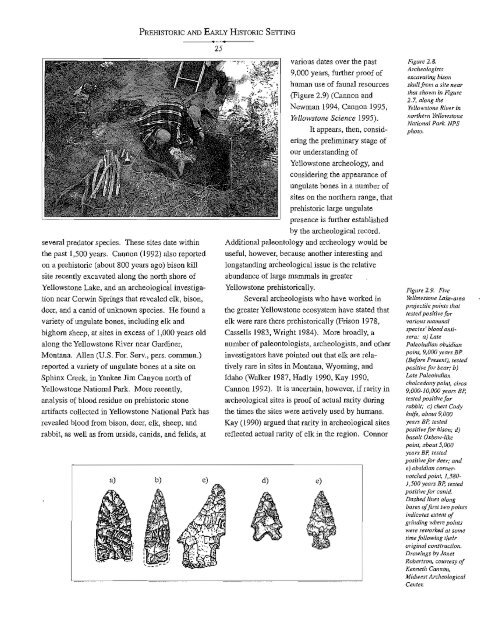Yellowstone's Northern Range - Greater Yellowstone Science ...
Yellowstone's Northern Range - Greater Yellowstone Science ...
Yellowstone's Northern Range - Greater Yellowstone Science ...
You also want an ePaper? Increase the reach of your titles
YUMPU automatically turns print PDFs into web optimized ePapers that Google loves.
PREHISTORIC AND EARLY HISTORIC SETTING<br />
several predator species. These sites date within<br />
the past 1,500 years. Cannon (1992) also reported<br />
on a prehistoric (about 800 years ago) bison kill<br />
site recently excavated along the north shore of ,<br />
<strong>Yellowstone</strong> Lake, and an archeological investigation<br />
near Corwin Springs that revealed elk, bison,<br />
deer, and a canid of unknown species. He found a<br />
variety of ungulate bones, including elk and<br />
bighorn sheep, at sites in excess of 1,000 years old<br />
along the <strong>Yellowstone</strong> River near Gardiner,<br />
Montana. Allen (U.S. For. Serv., pel's. commun.)<br />
reported a variety of ungulate bones at a site on<br />
Sphinx Creek, in Yankee Jim Canyon north of<br />
<strong>Yellowstone</strong> National Park. More recently,<br />
analysis of blood residue on prehistoric stone<br />
artifacts collected in <strong>Yellowstone</strong> National Park has<br />
revealed blood from bison, deer, elk, sheep, and<br />
rabbit, as well as from ursids, canids, and felids, at<br />
a) b)<br />
25<br />
various dates over the past<br />
9,000 years, further proof of<br />
human lise of faunal resources<br />
(Figure 2.9) (Cannon and<br />
Newman 1994, Cannon 1995,<br />
<strong>Yellowstone</strong> <strong>Science</strong> 1995).<br />
It appears, then, considering<br />
the preliminary stage of<br />
our understanding of<br />
<strong>Yellowstone</strong> archeology, and<br />
considering the appearance of<br />
ungulate bones in a number of<br />
sites on the northern range, that<br />
prehistoric large ungulate<br />
presence is further established<br />
by the archeological record.<br />
Additional paleontology and archeology would be<br />
useful, however, because another interesting and<br />
longstanding archeological issue is the relative<br />
abundance of large mammals in greater<br />
<strong>Yellowstone</strong> prehistorically.<br />
Several archeologists who have worked in<br />
the greater <strong>Yellowstone</strong> ecosystem have stated that<br />
elk were rare there prehistorically (Frison 1978,<br />
Cassells 1983, Wright 1984). More broadly, a<br />
number of paleontologists, archeologists, and other<br />
investigators have pointed out that elk are relatively<br />
rare in sites in Montana, Wyoming, and<br />
Idaho (Walker 1987, Hadly 1990, Kay 1990,<br />
Cannon 1992). It is uncertain, however, if rarity in<br />
archeological sites is proof of actual rarity during<br />
the times the sites were actively used by humans.<br />
Kay (1990) argued that rarity in archeological sites<br />
reflected actual rarity of elk in the region. Connor<br />
d) e)<br />
Figure 2.8.<br />
Archeologists<br />
excavating bison<br />
skull from a site near<br />
that shown in Figure<br />
2.7, along the<br />
<strong>Yellowstone</strong> River in<br />
nonhe/7/. <strong>Yellowstone</strong><br />
National Park. NPS<br />
photo.<br />
Figure 2.9. Five<br />
<strong>Yellowstone</strong> lLlke-area<br />
projectile poillls that<br />
tested positive for<br />
variOIlS mammal<br />
species' blood antisera:<br />
a) Late<br />
Paleoindian obsidian<br />
point, 9,000 years BP<br />
(Before PreselZl), tested<br />
positive for bear; b)<br />
Late Paleoindian<br />
chalcedony point, circa<br />
9,000-10,000 years BP,<br />
tested positive for<br />
rabbit; c) chert Cody<br />
knife, about 9,000<br />
years BP, tested<br />
positiveforbison; d)<br />
basalt Oxbow-like<br />
point, about 5,000<br />
years BP, tested<br />
positive for deer; and<br />
e) obsidian cornernotched<br />
point, 1,380-<br />
1,500 years BP, tested<br />
positive for canid.<br />
Dashed lines along<br />
bases of first two poilZls<br />
indicates extent of<br />
grinding where points<br />
were reworked at some<br />
time following their<br />
original construction.<br />
Drawings by Janet<br />
Robertson, COllrtesy of<br />
Kenneth Canlloll,<br />
Midwest Archeological<br />
Center.















